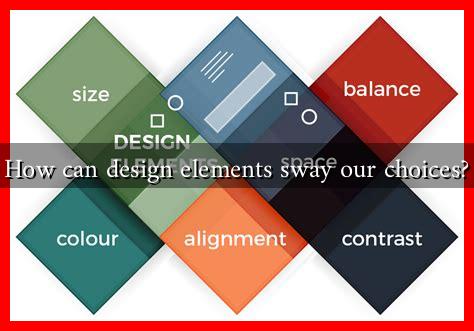-
Table of Contents
How Can Design Elements Sway Our Choices?
Design elements play a crucial role in influencing our decisions, whether we are aware of it or not. From the colors of a website to the layout of a product, every design choice can impact our perceptions and behaviors. This article explores how various design elements sway our choices, supported by research, examples, and case studies.
The Psychology of Color
Color is one of the most powerful design elements that can evoke emotions and influence decisions. According to a study by the Institute for Color Research, people make a subconscious judgment about a person, environment, or product within 90 seconds of initial viewing, and between 62% to 90% of that assessment is based on color alone.
- Red: Often associated with urgency, red can stimulate appetite and is frequently used in food marketing.
- Blue: Conveys trust and dependability, making it a popular choice for financial institutions.
- Green: Represents health and tranquility, often used in eco-friendly products.
For instance, the fast-food chain McDonald’s uses red and yellow in its branding to create a sense of urgency and stimulate hunger. In contrast, tech companies like Facebook and Twitter use blue to promote trust and reliability.
Typography: The Unsung Hero of Design
Typography is another critical design element that can influence our choices. The font style, size, and spacing can affect readability and perception. A study published in the journal Psychological Science found that people are more likely to choose products presented in easy-to-read fonts.
- Serif Fonts: Often perceived as more traditional and trustworthy.
- Sans-Serif Fonts: Seen as modern and clean, appealing to younger audiences.
- Script Fonts: Can evoke elegance and creativity but may hinder readability.
For example, the luxury brand Tiffany & Co. uses a serif font in its branding to convey sophistication and tradition, while tech startups often opt for sans-serif fonts to project a modern image.
Layout and Visual Hierarchy
The layout of a design can significantly impact how information is processed and decisions are made. Visual hierarchy guides the viewer’s eye and emphasizes the most important elements. A well-structured layout can lead to better user experience and higher conversion rates.
- F-Shaped Pattern: Research shows that users often scan web pages in an F-shaped pattern, focusing on the top and left side of the page.
- White Space: Effective use of white space can enhance readability and focus attention on key elements.
- Call-to-Action (CTA): Strategically placed CTAs can significantly increase conversion rates.
For instance, the e-commerce giant Amazon uses a clear layout with prominent CTAs, making it easy for users to navigate and make purchases. A/B testing has shown that small changes in layout can lead to significant increases in sales.
Case Studies: Real-World Applications
Several companies have successfully leveraged design elements to influence consumer behavior:
- Airbnb: The use of high-quality images and a clean layout on their website enhances user experience and encourages bookings.
- Apple: Minimalist design and consistent branding create a sense of luxury and exclusivity, influencing consumer choices.
- Coca-Cola: The iconic red and white branding evokes feelings of happiness and nostalgia, swaying consumer preferences.
Conclusion: The Power of Design in Decision-Making
Design elements are not just aesthetic choices; they are powerful tools that can sway our decisions in profound ways. From color psychology to typography and layout, every design choice can influence perceptions and behaviors. Understanding these elements can help businesses create more effective marketing strategies and improve user experiences.
As consumers, being aware of how design influences our choices can empower us to make more informed decisions. Whether you are a marketer, designer, or consumer, recognizing the impact of design elements can lead to better outcomes in both personal and professional contexts.
For further reading on the psychology of design, you can explore resources like Smashing Magazine.

